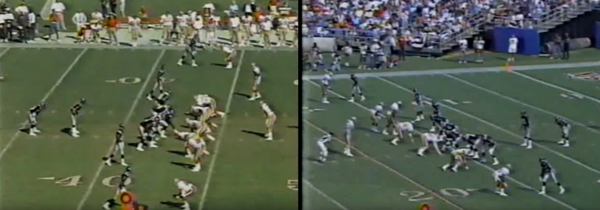
The quarterback, colloquially known as the "signal caller", is a position in gridiron football. Quarterbacks are members of the offensive platoon and mostly line up directly behind the offensive line. In modern American football, the quarterback is usually considered the leader of the offense, and is often responsible for calling the play in the huddle. The quarterback also touches the ball on almost every offensive play, and is almost always the offensive player that throws forward passes. When the QB is tackled behind the line of scrimmage, it is called a sack.
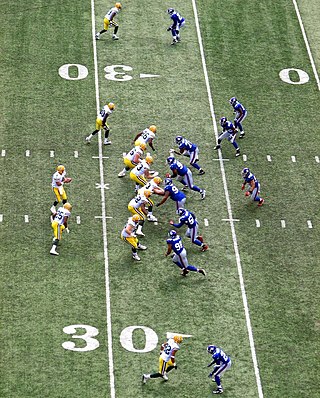
The shotgun formation is a formation used by the offensive team in gridiron football mainly for passing plays, although some teams use it as their base formation. Instead of the quarterback receiving the snap from center at the line of scrimmage, in the shotgun he stands farther back, often five to seven yards off the line. Sometimes the quarterback will have a back on one or both sides before the snap, while other times he will be the lone player in the backfield with everyone spread out as receivers.
Strategy is a major part of American football.

An option offense is an American football offensive system in which a key player has several "options" of how each play will proceed based upon the actions of the defense. Traditionally, option-based offenses rely on running plays, though most mix in forward passes from an option formation as a change of pace. A successful option-based offense can keep possession of the ball for long periods of time, giving the opposing offense fewer possessions and keeping the option team's defense rested. However, because passing is often not a strength of the system, it can be difficult for option-based offenses to come back from a large deficit or to score quickly when needed.
The halfback option play is an unorthodox play in American and Canadian football. It resembles a normal running play, but the running back has the option to throw a pass to another eligible receiver before crossing the line of scrimmage.

Single set back is an offensive base formation in American football which requires only one running back lined up about five yards behind the quarterback. There are many variations on single back formations including two tight ends and two wide receivers, one tight end/three wide receivers, etc. The running back can line up directly behind the quarterback or offset either the weak side or the strong side.
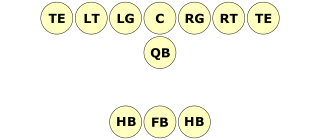
In American football, a T formation is a formation used by the offensive team in which three running backs line up in a row about five yards behind the quarterback, forming the shape of a "T".

In American football, the specific role that a player takes on the field is referred to as their "position". Under the modern rules of American football, both teams are allowed 11 players on the field at one time and have "unlimited free substitutions", meaning that they may change any number of players during any "dead ball" situation. This has resulted in the development of three task-specific "platoons" of players within any single team: the offense, the defense, and "special teams". Within these three separate "platoons", various positions exist depending on the jobs that the players are doing.

The flexbone formation is an offensive formation in American football that includes a quarterback, five offensive linemen, three running backs, and varying numbers of tight ends and wide receivers. The flexbone formation is derived from the wishbone formation and features a quarterback under center with a fullback lined up directly behind the quarterback. There are two smaller running backs called slotbacks aligned behind the line of scrimmage on each side of the offensive line. The slotbacks are sometimes incorrectly referred to as wingbacks. But in order to be a wingback, there must be a guard, tackle and tight end all on one side of the center on the line of scrimmage and then the wingback off the line of scrimmage.

The triple option is an American football play used to offer six ways to move the football forward on the field of play. The triple option is based on the option run, but uses three players who might run with the ball instead of the two used in a standard option run.

The spread offense is an offensive scheme in gridiron football that typically places the quarterback in the shotgun formation, and "spreads" the defense horizontally using three-, four-, and even five-receiver sets. Used at every level of the game including professional, college, and high school programs across the US and Canada, spread offenses often employ a no-huddle approach. Some implementations of the spread also feature wide splits between the offensive linemen.
In American football, a play is a close-to-the-ground plan of action or strategy used to move the ball down the field. A play begins at either the snap from the center or at kickoff. Most commonly, plays occur at the snap during a down. These plays range from basic to very intricate. Football players keep a record of these plays in a playbook.

The Veer is an option running play often associated with option offenses in American football, made famous at the collegiate level by Bill Yeoman's Houston Cougars. It is currently run primarily at high school level, with some usage at the collegiate and the professional level where Veer's blocking scheme has been modified as part of the zone blocking system. The Veer is an effective ball-control offense that can help minimize mismatches in a game for a team. However, it can lead to turnovers with pitches and handoff option reads.
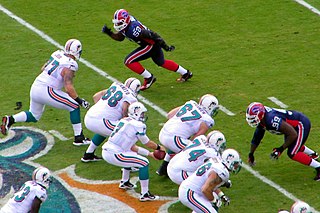
A pro-style offense in American football is any offensive scheme that resembles those predominantly used at the professional level of play in the National Football League (NFL), in contrast to those typically used at the collegiate or high school level. Pro-style offenses are fairly common at top-quality colleges but much less used at the high school level. The term should not be confused with a pro set, which is a specific formation that is used by some offenses at the professional level.
The following terms are used in American football, both conventional and indoor. Some of these terms are also in use in Canadian football; for a list of terms unique to that code, see Glossary of Canadian football.
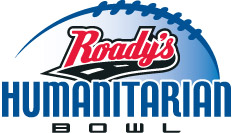
The 2008 Humanitarian Bowl was a postseason college football bowl game between the Maryland Terrapins and the Nevada Wolf Pack on December 30, 2008. It was the two teams' first meeting. The game featured two conference tie-ins: the University of Maryland represented the Atlantic Coast Conference (ACC) and the University of Nevada represented the Western Athletic Conference (WAC). The game was played at Bronco Stadium in Boise, Idaho and was the 12th edition of the Humanitarian Bowl. It was sponsored by the New Plymouth, Idaho-based company Roady's Truck Stops, which claims to be the largest chain of truck stops in the United States.
The 2008 Nevada Wolf Pack football team represented the University of Nevada, Reno during the 2008 NCAA Division I FBS football season. Nevada competed as a member of the Western Athletic Conference (WAC). The Wolf Pack were led by Chris Ault in his 24th overall and 5th straight season since taking over as head coach for the third time in 2004. They played their home games at Mackay Stadium.
Pistol-Flex or Pistol Double-Slot is a hybrid of two well-known American football formations: the pistol and flexbone formations. It was pioneered in 2009 by Paul Markowski, who is currently an offensive consultant for Chestnut Hill College. By combining the strengths of each offensive set, the result is a formation that is very effective for both passing and running. The triple option can be used from this set very effectively. Markowski has developed a true quadruple option play run out of the Pistol-Flex formation.
The run and shoot offense is an offensive system for American football which emphasizes receiver motion and on-the-fly adjustments of receivers' routes in response to different defenses. It was conceived by former high school coach Glenn "Tiger" Ellison and refined and popularized by former Portland State offensive coordinator Mouse Davis.

